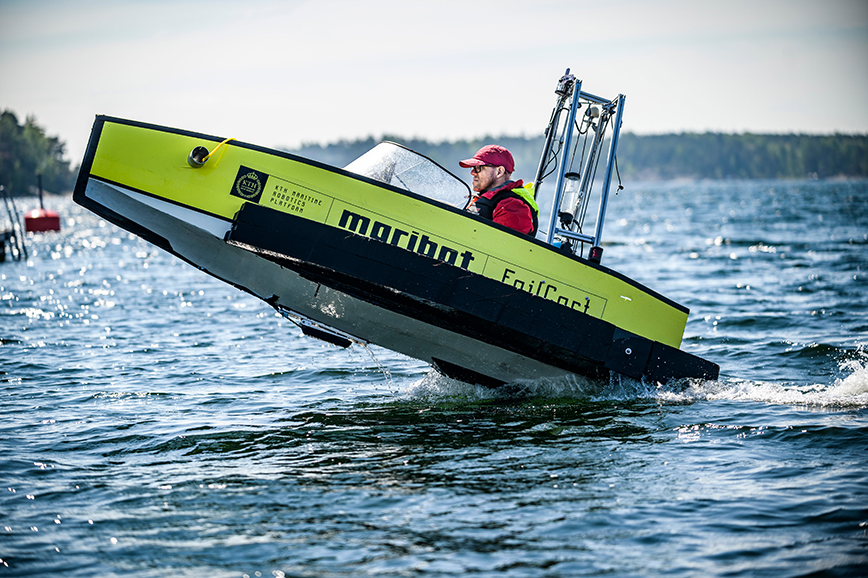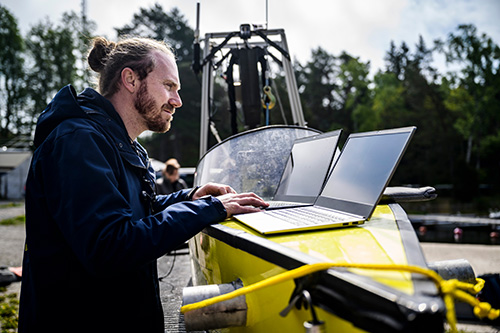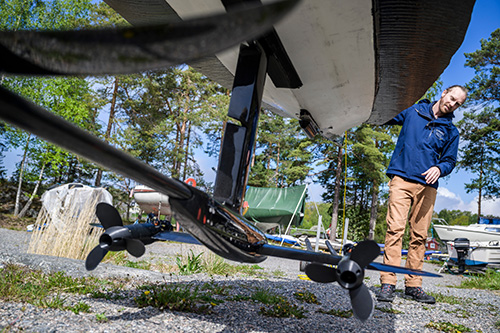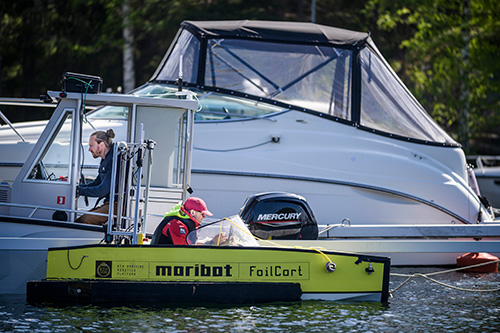Boats that fly like the wind

Silent zero-emission vessels that swiftly float past the cobs and skerries – is this the future of coastal and open-water boating? We paid a visit to the KTH Värmdö field station, where researchers are busy testing and developing an electric boat.
Behind a fence that surrounds the Djurö wastewater plant is a modular blue container building with ‘Djurö Marina Field Station’ inscribed on the sign. This is where innovative, sustainable maritime vessels are being built to explore the ocean – from the pelagic to the benthic realm and everywhere in between.
Just a stone’s throw from the Djurö Boating Club marina, KTH researchers Ivan Stenius and Nicholas Honeth are preparing to launch the Foilcart test boat – their silent, zero-emissions leisure and transport concept vessel.

The boat is rigged with advanced software, sensors, computers and a hydroplane foil, which allows it to hover gracefully above the water. This state-of-the-art technology reduces drag by 50–80 per cent – a necessity for electric propulsion.
“We get both higher speed and better range. One positive effect is that no waves are generated. It’s like riding first-class in a railcar – nice and peaceful,” maintains Mr Stenius, Research Director at the KTH Department of Vehicle Technology and Solid Mechanics.
Trimming the steering system
Thanks to the simplified hydrofoil design and lower manufacturing costs, the Foilcart is less expensive than similar electric boat options.
“That’s one of the points of our project. For electric boats to gain widespread acceptance, the prices have to come down to the level of ordinary boats,” acknowledges Mr Stenius.
A couple times a week, the researchers take to the sea to test out and improve the control system. They tweak the computer algorithms and trim the steering system to keep the vessel balanced during operation and counter the effects on the boat of waves, winds, weather and weight displacement.

The 3.5 metre-long vessel is fully equipped with microcomputers. Advanced sensors transmit control signals to the rudder based on readings that are taken 200 times a second.
Just before the day’s test run, Nicholas Honeth, an electrotechnology researcher, makes a few final corrections.
“It’s about several functions that control how the boat should lean on inner turns. I need to tweak the code a bit,” he says while looming over the computer screen waiting for the Foilcart to be lowered onto the water.
The ebb and flow of progress
When the neon-yellow vessel steals away with Mr Stenius at the helm, Mr Honeth makes himself comfortable in the ‘office’, a consort boat equipped with Wi-Fi, tracking computers and a heated cabin, which is moored today at the jetty along with the usual assortment of sailboats and speedboats.
In spite of several attempts, the boat fails to maintain its balance whilst rising above the surface. It rises and falls flat, several times in succession. The mystery’s revealed once they hoist the Foilcart up again with the crane – the elevator had loosened and now lies somewhere at the bottom of the sea.

“Mechanical defects are highly unusual. But that’s how it is with experimental research – always a learning process,” acknowledges Mr Honeth.
The planned demonstration for financiers and stakeholders may need to be postponed a bit from the end of summer.
Chance to make a difference
“We’re about to introduce the world’s most compact hydrofoil system technology for boats. Once we’re able to get it to maintain its balance whilst hovering, we’ll be the first in the world with this concept,” says Mr Stenius.
Exactly when hydrofoil technology will gain widespread acceptance is anyone’s guess.
“In part, it’s all about demand and the public perception of ‘flying’ over water. If we can get businesses and other stakeholders on board, it should only be a matter of a few years before we can take the next step,” he says, adding:
“If we’re to reach the goal of a fossil-free society, maritime transport and the boating industry must also play a role. Hydrofoil technology offers the potential to really make a difference.”
Text: Christer Gummeson
Photos: Marc Femenia

